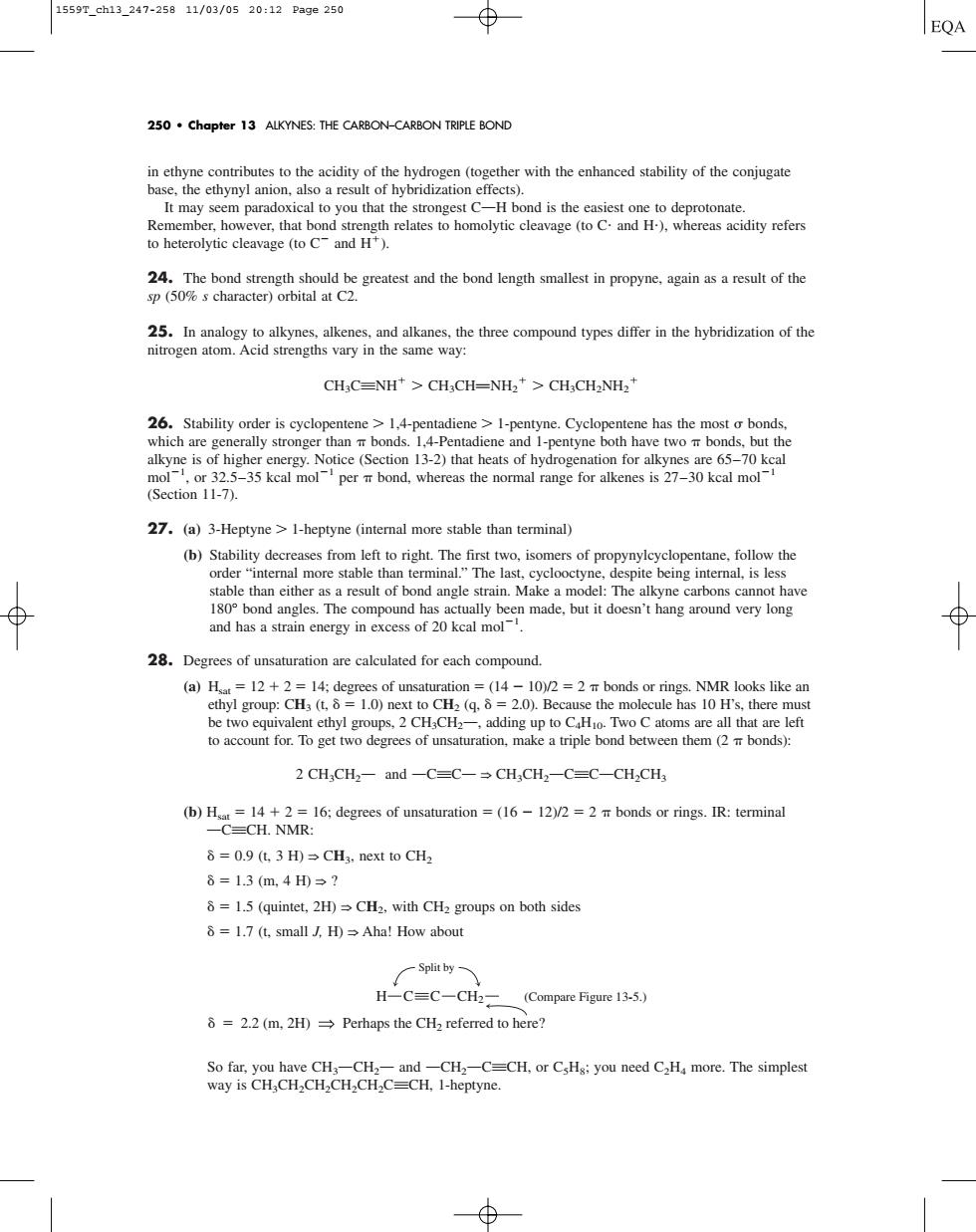正在加载图片...

1559T_ch13_247-25811/03/0520:12Pa9e250 ⊕ EQA 250.Chapter 13 ALKYNES:THE CARBON-CARBON TRIPLE BOND s to the acidity of the hyd gen(together with the enhanced stability of the conjugate It may se atoyou that the stronges nd is the molytic greatest and the bond length smallest in propyne.again asa result of th 25ehmXahm ths vary in the anes. he three compound types differ in the hybridization of the CHC=NH*CH,CH=NH2*>* -pentyne both have twobonds.but the n 13-2)tha t heats of hydroge 1a0 normal (Section 11-7). 27.(a)3-Heptyne1-heptyne (internal more stable than terminal) (b)Stability decreases from left to right.The first two,isomers of propynylcyclopentane,follow the more s spite eing inter 18bond angles.The compound has b ng around very long 28.Degrees of unsaturation are calculated for each compound. (a) H=12+2=14: be two equivalent ethyl groups.2 CHCHa- -adding up to C4Ho.Two C atoms are all that are lef to account for.To get two degrees of unsaturation,make a triple bond between them (2 bonds) 2 CH:CH,-and-C=C-CH,CH,-C=C-CH,CH =0.9 (t.3 H)CHa.next to CH2 8=1.3(m,4H田→? =1.5(quintet,2H)CH2,with CH2 groups on both side 8=1.7 (t,small J.H)Aha!How about 一spy H-C=C-CH2-(Compare Figure 13-5.) =2.2 (m,2H)Perhaps the CHa referred to here? in ethyne contributes to the acidity of the hydrogen (together with the enhanced stability of the conjugate base, the ethynyl anion, also a result of hybridization effects). It may seem paradoxical to you that the strongest COH bond is the easiest one to deprotonate. Remember, however, that bond strength relates to homolytic cleavage (to C and H), whereas acidity refers to heterolytic cleavage (to C and H). 24. The bond strength should be greatest and the bond length smallest in propyne, again as a result of the sp (50% s character) orbital at C2. 25. In analogy to alkynes, alkenes, and alkanes, the three compound types differ in the hybridization of the nitrogen atom. Acid strengths vary in the same way: CH3CqNH CH3CHPNH2 CH3CH2NH2 26. Stability order is cyclopentene 1,4-pentadiene 1-pentyne. Cyclopentene has the most bonds, which are generally stronger than bonds. 1,4-Pentadiene and 1-pentyne both have two bonds, but the alkyne is of higher energy. Notice (Section 13-2) that heats of hydrogenation for alkynes are 65–70 kcal mol1 , or 32.5–35 kcal mol1 per bond, whereas the normal range for alkenes is 27–30 kcal mol1 (Section 11-7). 27. (a) 3-Heptyne 1-heptyne (internal more stable than terminal) (b) Stability decreases from left to right. The first two, isomers of propynylcyclopentane, follow the order “internal more stable than terminal.” The last, cyclooctyne, despite being internal, is less stable than either as a result of bond angle strain. Make a model: The alkyne carbons cannot have 180° bond angles. The compound has actually been made, but it doesn’t hang around very long and has a strain energy in excess of 20 kcal mol1 . 28. Degrees of unsaturation are calculated for each compound. (a) Hsat 12 2 14; degrees of unsaturation (14 10)/2 2 bonds or rings. NMR looks like an ethyl group: CH3 (t, 1.0) next to CH2 (q, 2.0). Because the molecule has 10 H’s, there must be two equivalent ethyl groups, 2 CH3CH2O, adding up to C4H10. Two C atoms are all that are left to account for. To get two degrees of unsaturation, make a triple bond between them (2 bonds): 2 CH3CH2O and OCqCO F CH3CH2OCqCOCH2CH3 (b) Hsat 14 2 16; degrees of unsaturation (16 12)/2 2 bonds or rings. IR: terminal OCqCH. NMR: 0.9 (t, 3 H) F CH3, next to CH2 1.3 (m, 4 H) F ? 1.5 (quintet, 2H) F CH2, with CH2 groups on both sides 1.7 (t, small J, H) F Aha! How about So far, you have CH3OCH2O and OCH2OCqCH, or C5H8; you need C2H4 more. The simplest way is CH3CH2CH2CH2CH2CqCH, 1-heptyne. HCC Split by CH2 (Compare Figure 13-5.) 2.2 (m, 2H) Perhaps the CH2 referred to here? 250 • Chapter 13 ALKYNES: THE CARBON–CARBON TRIPLE BOND 1559T_ch13_247-258 11/03/05 20:12 Page 250������������